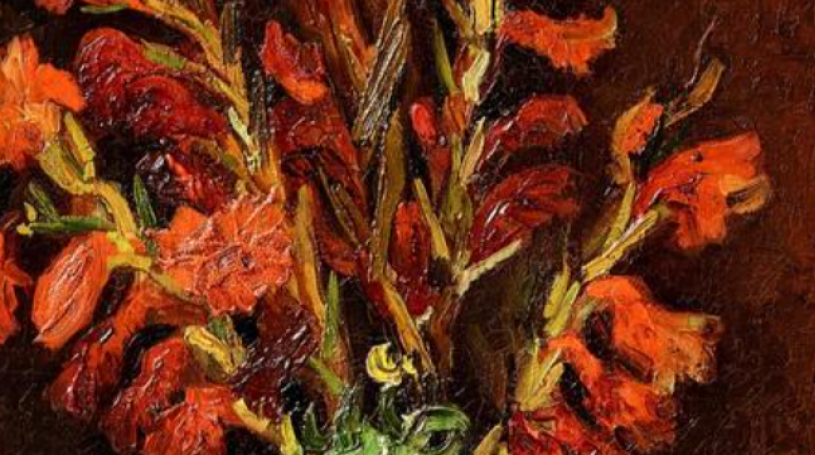Van Gogh goes East: for the first time, Sotheby’s is to auction his work in Hong Kong
For the first time a Van Gogh painting is being auctioned in the Far East by one of the West's major auction houses—a sure sign that the market is shifting away from Europe and North America. The main buyers of Vincent’s work are now in China, Hong Kong and Korea.
Still life: Vase with Gladioli (Nature Morte: Vase aux Glaïeuls) (August-September 1886) is to be offered at Sotheby’s, Hong Kong on 9 October. The estimate is HK$70m-HK$100m ($9m-$12.8m).
In the painting, the bright red gladioli tower above the small pot, which sits on a dark table that blends into the background. They usually flower in August and September in northern France and Still life: Vase with Gladioli is a good example of the artist’s style at this time, a few months after his arrival in Paris in February 1886. The fact that it is signed may mean that Vincent gave it to one of his artist friends.
Vincent’s brother Theo reported to their mother in July: “He is mainly painting flowers—with the object to put a more lively colour into his next set of pictures... He also has acquaintances who give him a bunch of flowers every week.”
Writing in English to his artist friend Horace Livens, Vincent reported in September/October 1886: “I have made a series of colour studies in painting simply flowers… Trying to render intense COLOUR and not a grey harmony.” At this time he made several other still lifes with gladioli, including Vase with Gladioli and Chinese Asters (August-September 1886), now in the Van Gogh Museum collection.
The gladioli work coming up in Hong Kong was painted over an earlier still life—one of potatoes and a bowl. This original composition probably dates from a year earlier, September 1885, when Van Gogh was living in his parents’ village of Nuenen, in the southern Netherlands. Always being short of money, he probably simply reused the canvas after his arrival in Paris. The Sotheby’s catalogue entry also suggests that he overpainted the earlier work because he “felt his art moving in a new and exciting direction”.
The first identified owner of Still life: Vase with Gladioli was the Parisian critic and supporter of Impressionism, Théodore Duret, who owned it by 1912. By 1928 it was with Alden Brooks, a US writer who was living in Paris and became best known for arguing that Shakespeare was not the dramatist of the plays ascribed to him.
In the past 40 years Still life: Vase with Gladioli has been put up for auction at Sotheby’s no fewer than five times. This offers an unusual opportunity to see how prices have fared.
In 1983 the still life sold for $150,000, going to the Florida-based collector Elwin Litchfield Phillips Jr. When his estate sold the picture in 1999 it fetched $1,762,000—a price increase of nearly 12 times. Two years later it came up for sale again, estimated at $1.2m-$1.6m, significantly less than the previous time—but it failed to sell.
In November 2016 the US owner successfully sold the still life for a hammer price of $5,862,500. When it comes up in Hong Kong on 9 October, the estimate of $9m-$12.8m is roughly double what it achieved five years ago. This rise is partly because Far Eastern demand is pushing up prices for Van Gogh works.
Another still life, Poppies and Daisies (June 1890), sold at Sotheby’s in 2014 for nearly $62m. This work had been painted in Auvers-sur-Oise a month before Vincent’s death, when he was at the height of his powers. The buyer was the billionaire Wang Zhongjun, the owner of a Beijing entertainment company and himself an amateur artist. No doubt Sotheby’s was partly influenced by this successful sale in setting the estimate for Still life: Vase with Gladioli.
Other Van Gogh news
• On 9 October the Kunsthaus Zurich will open its magnificent new extension, designed by the British architect David Chipperfield and costed at SF206m (£165m). The gallery will then have 15 Van Gogh works on its walls, making it one of the world’s largest collections outside the Netherlands (along with the Musée d’Orsay in Paris and New York’s Metropolitan Museum of Art). Three Van Gogh paintings are owned by the Kunsthaus; three are on loan from an anonymous private collection (believed to be the family of the Greek shipowner Stavros Niarchos, who died in 1996); and two are on loan from other private collectors. Seven belong to the Emil Bührle foundation, amassed by that collector (1890-1956) and now on long-term loan to the Kunsthaus. The Bührle foundation's director, Lukas Gloor, has just published the definitive account of how the collection was amassed: The Emil Bührle Collection: History, Full Catalogue, and 70 Masterpieces (Hirmer, Munich).
• A Dutch thief, named as Nils M. (from Baarn, near Utrecht), has been sentenced to eight years’ imprisonment for his role in two art thefts. In March 2020 Van Gogh’s Parsonage Garden at Nuenen in Spring (March 1884), then on loan from the Groninger Museum, was stolen from the Singer Laren museum. The court was told that the Van Gogh landscape is valued at €2.5m. In August 2020 Nils M. then stole a Hals, Two Laughing Boys (around 1626), from a museum in Leerdam. Both paintings are still missing.

